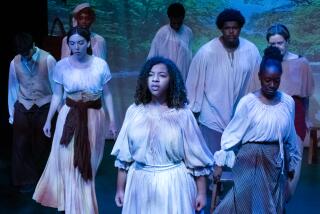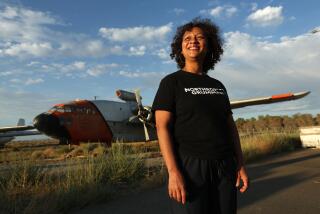Saddleback College District’s Renaissance Man : English Professor Peter Morrison’s New Task Is to Lead the Campuses Online
- Share via
Peter Morrison, an English and humanities professor who has spent much of his life in contemplation of Renaissance ideas, has devoted the last year to thinking a lot about computers.
The 48-year-old Irvine Valley College professor is overseeing the two-campus Saddleback College District’s entry into the age of the Internet.
It is not a responsibility he envisioned as a graduate student in England, majoring in Renaissance drama at the University of Sussex. But he clearly sees a kind of historical continuity in the connection of America’s schools and universities to the Internet and the creation of information networks within those campus communities.
“The only reason that we have the Elizabethan plays at all is because some typesetters managed to get those texts printed for us,” said Morrison, a Laguna Beach resident who grows hybrid roses. “There’s always been a technological side to literacy. Arguably, literacy is a technological act.
“The Internet allows for a degree of self-publication to an extent we’ve never before seen. It’s like the world’s largest vanity press. And the library of information that is suddenly available has given us the ability to access information in ways that we’ve never been able to do before. It’s like having the finest reference library in the world at your fingertips.”
After the installation of 150 miles of fiber optic cable to 2,700 work station outlets throughout the college district, the new computer network went online March 31. But there is still much work to be done. Morrison envisions a virtual university, where students can register for classes from remote computers and do academic research on the Internet through computer links found on the Web sites of their instructors.
“We began with the premise that this was going to be an academic network that the administrative functions of the district would also utilize, not an administrative network that the faculty and students could tap into.
“Self-publishing and information access are the two fundamental functions of the new network. It will enable faculty members to utilize the network for the publication and distribution of content in their courses. So, if I want to post my syllabus for my Renaissance course, I will not be going to the photocopier and running off a bunch of copies and handing them out when everyone gathers at my first class. I would post it on the network.
“Because this kind of publishing is not limited to text, I can then publish other kinds of files--audio files, video files or images--that might be useful. The course content itself will be available in an electronic form, along with lecture notes. That will be extremely useful in all kinds of academic settings.”
But as the Saddleback district’s computer networks evolve, Morrison and other college officials find themselves forced to consider placing limits on access to information, an unpalatable prospect for defenders of academic freedom.
“There are few effective social filtering mechanisms on the net. There are some, but they are very modest in nature. We now have access to things without the social barriers and obstacles that existed in the past. That’s to the good, and to the bad.”
The U.S. Supreme Court is weighing a similar technological conundrum: How much freedom is too much when it comes to the Internet? The justices are weighing whether to uphold some or all of the Communications Decency Act, a 1996 federal law that makes it a crime to send pornography over the Internet. The law was struck down as unconstitutional last year by a three-judge panel in Philadelphia.
Opponents of the law warn it could restrict legitimate artistic and literary works as well as discussions about sex on the Internet.
“I would hope that whatever kind of restrictions that are placed on the Internet would not inhibit appropriate academic use or our ability to look into things that are unpopular,” Morrison said.
“A college is supposed to be able to explore all kinds of unpopular and controversial ideas. That’s one of the things the institution does socially for us, to enable us to have those kinds of discussions without fear of people losing their jobs or students being thrown out of school.
“We wouldn’t want to see restrictions become an inhibiting factor in our ability to do that.
“But it is a public resource and we do have obligations to the public and to our students, to protect them against things that might be intrusive. There’s a point at which freedom crosses over into harassment, and those lines are always gray.”
(BEGIN TEXT OF INFOBOX / INFOGRAPHIC)
Profile: Peter Morrison
Age: 48
Hometown: Riverside
Residence: Laguna Beach
Family: Wife, Elaine
Education: Bachelor’s degree in English literature, Pomona College; master’s degree in Renaissance drama, University of Sussex (England); doctorate in literature and literary criticism, UC Irvine
Background: Postdoctoral fellowships and research at Northwestern University, University of Chicago, Trinity College (Dublin), Christ Church College (Oxford); assistant professor of English at University of Texas; assistant professor of English at Saddleback College; professor of English and humanities at Irvine Valley College since 1980; assistant to chancellor of Saddleback Community College District; director of district’s Technology Initiative
On the Wired College: “Being able to apply to the academic institution using the computer network, being able to register online for classes and to communicate with instructors--that is a big part of what we’re involved in doing. This institution no longer has to exist only as a physical environment.”
Source: Peter Morrison; Researched by RUSS LOAR / For The Times
More to Read
Sign up for Essential California
The most important California stories and recommendations in your inbox every morning.
You may occasionally receive promotional content from the Los Angeles Times.













